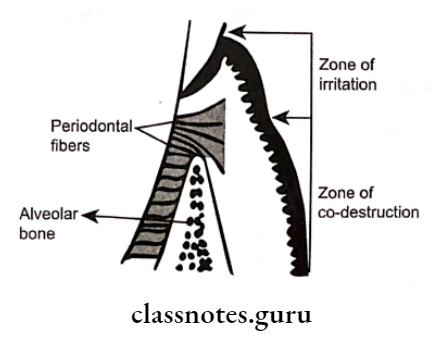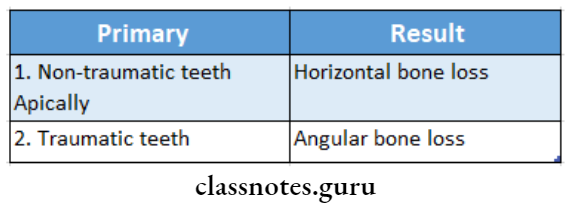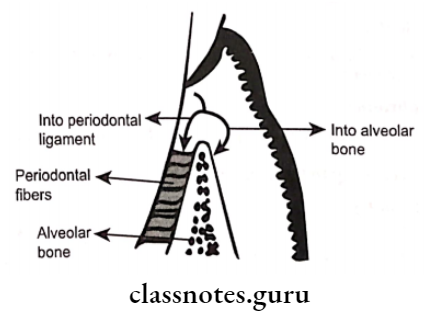Trauma From Occlusion Definitions
1. Trauma From Occlusion
- When occlusal forces exceed the adaptive capacity of the periodontal tissues, the tissue injury results
- This resultant injury is termed trauma from occlusion.
2. Pathological Migration Of teeth
- Pathological migration of teeth refers to tooth displacement that results when the balance among the factors that maintain physiologic tooth position is disturbed by periodontal disease
Trauma From Occlusion Important Notes
1. Types of trauma from occlusion
- Primary trauma from occlusion
- Occurs due to excessive occlusal forces
- Changes produced by it do not alter the level of connective tissue
- It does not initiate the pocket formation
- As suprarenal fibres are not affected it prevents apical migration of junctional epithelium
- Secondary trauma from occlusion
- Occurs when the adaptive capacity of the tissues to withstand occlusal forces is impaired by bone loss resulting from marginal inflammation
Read And Learn More: Periodontics Question and Answers
2. Trauma from occlusion does not cause pockets or gingivitis as the marginal gingiva is unaffected by trauma from occlusion because of its rich blood supply
- But trauma from occlusion may affect the progress and severity of periodontal pockets started by local irritation
3. Signs and symptoms of trauma from occlusion
- Tooth pain, sensitivity to percussion
- Increased tooth mobility
- Cementum tears
- Widening of periodontal space
- Root resorption
- Thickening of lamina dura
- Vertical or angular bone defects
4. Buttressing bone formation
- When excessive occlusal forces resorb bone, the bone attempts to reinforce the thinned bony trabeculae with new bone
- This attempt to compensate for lost bone is called buttressing bone formation
- Buttressing bone formation may be central or peripheral
- Peripheral buttressing bone formation is also called lipping.
5. Increased tooth mobility is the most common finding of trauma from occlusion
- This is due to the destruction of periodontal fibres in the injury stage and the widening of the periodontal ligament in the final adaptation stage of trauma from occlusion
Trauma From Occlusion Long Essays
Question 1. Define and classify trauma from occlusion. Discuss the stages of tissue response to increased occlusal forces.
Answer:
Trauma Definition:
- When occlusal forces exceed the adaptive capacity of the periodontal tissues, the tissue injury results
- This resultant injury is termed trauma from occlusion.
Trauma Classification:
1. According to the Onset:
Acute: Due to abrupt occlusal forces.
Acute Example: Biting on a hard object
Chronic: Due to gradual changes in the periodontium
Chronic Example: Bruxism
2. According to the cause:
Primary:
- When trauma from occlusion results from the alteration of occlusal forces
- Do not alter the level of connective tissue attachment
- Do not initiate pocket formation because suprarenal gingival are not affected which prevents apical migration of junctional epithelium
Secondary:
- When trauma from occlusion results due to the reduced ability of tissues to resist occlusal forces
- Adaptive capacity is impaired by bone loss resulting from marginal inflammation
- Reduces PDL attachment
- Alters leverage on remaining tissues

Tissue Response:
Stage 1 – Injury:
Application of excessive occlusal forces
↓
Distribution of periodontal tissues
↓
Adaptation of periodontal structures to altered forces
↓
On horizontal forces tooth rotates, 2 zones appear
- Pressure zone
- Tension zone
Stage 2 – Repair:
Excessive occlusal forces lead to the resorption of bone
↓
Bone formation from thinned bony trabeculae is called “Buttressing Bone formation”
- Within the jaw “Central Buttressing”
- On bone surface “Peripheral Buttressing”
- Shelf-like thickening of alveolar bone “Lipping”
Stage 3: Adaptive Remodelling of Periodontium:
- Occurs when the repair cannot cope with the destruction
- Results in
- Thickening of periodontal ligament
- Angular bone defects

Trauma From Occlusion Short Essays
Question 1. Clinical and Radiological features of TFO.
Answer:
TFO Clinical Features:
1. Acute:
- Excessive tooth pain
- TOP positive
- Mobility of teeth
- Periodontal abscess
- Pathologic migration of teeth
- If force is dissipated, symptoms subside
2. Chronic:
- No pain is present
- Deep bite
- Symptom-free condition
- Fremitus test-positive
TFO Radiographic Changes:
- Widening of PDL space
- Vertical bone loss
- Angular facets
- Root resorption
Question 2. Glickman’s concept.
Answer:
Glickman explained the path of progression of disease along with its result

Glickman’s Zones:
1. Zone of Irritation:
Marginal and interdental gingival inflammation
↓
Passes apically to alveolar bone
↓
Then to the PDL area
↓
Results in horizontal bone loss
2. Zone of Co-destruction:
Trauma from occlusion
↓
Involvement of PDL, cementum and bone
↓
Spread of infection directly to PDL
↓
Results in angular bone loss

Question 3. Types of Trauma from Occlusion.
Answer:
Trauma From Occlusion Classification:
1. According to the onset:
- Acute:
- Due to abrupt occlusal forces. Ex- biting on a hard object
- Chronic:
- Due to gradual change in periodontium.
Example: bruxism
2. According to the cause:
Primary:
- When trauma from occlusion results from al-iteration of occlusal forces, it results in primary trauma from occlusion
- It does not alter the level of connective tissue attachments
- It does not initiate pocket formation because suprarenal gingival fibres are not affected which prevents apical migration of junctional epithelium
Secondary:
- It is trauma from occlusion that results in to reduced ability of tissues to resist occlusal forces
- Adaptive capacity is impaired by bone loss re- resulting from marginal inflammation
- Reduces periodontal attachment
- Alters leverage on remaining tissues
Question 4. Tissue response to trauma from occlusion.
Answer:
Stage 1-Injury:
Application of excessive occlusal forces
↓
Distribution of forces to periodontal tissues
↓
Adaptation of periodontal structures to altered forces
↓
On application of horizontal forces tooth rotates
↓
Two zones appear- The pressure zone and tension zone
Stage 2-Repair:
- Excessive forces lead to the resorption of bone
- When bone is resorbed in such cases, the body attempts to reinforce trabeculae to form new bone
- This process is called buttressing
Trauma From Occlusion Types:
1. Central buttressing:
- In it, endosteal cells deposit new bone
- It restores bony trabeculae
- Reduces the size of bone marrow
2. Peripheral buttressing:
- Occurs on facial and lingual surfaces of bone
- May produce shelflike thickening of the alveolar margin called lipping
- It is a pronounced bulge in the contour of the facial or lingual bone
Stage 3- Adaptative Remodelling:
- Adaptive remodelling of periodontium occurs
- It occurs when the repair cannot cope with the destruction
- It results in
- Thickening of periodontal ligament
- Angular bone defects
- Loosening of teeth
Question 5. Pathological migration of teeth
Answer:
Pathological migration of teeth refers to tooth displacement that results when the balance among the factors that maintain physiologic tooth position is dis- turned by periodontal disease
Pathogenesis: Factors that maintain the normal position of teeth are
1. Health and normal height of the periodontium:
- A tooth with weakened periodontal support is unable to withstand the forces and moves away from the opposing force
- Forces that are acceptable to an intact period of- time become injurious when periodontal support is reduced
2. Forces exerted on the teeth: Changes in the forces may occur as a result of
- Unreplaced missing teeth
- It leads to the drifting of teeth into spaces created by unreplaced missing teeth
- Failure to replace first molars- It consists of
- Tilting of second and third molars leading to the reduced vertical dimension
- Premolars move distally
- Mandibular incisors tilt or drift lingually -Increase in an anterior overbite
- Maxillary incisors are pushed labially and laterally
- Extrusion of anterior teeth
- Diastema
- Other causes
- Pressure from the tongue
- Pressure from the granulation tissue of the periodontal pocket
Trauma From Occlusion Viva Voce
- Furcation areas are most susceptible to injury from trauma from occlusion
- Pathological migration occurs mostly in the anterior region
- The tooth moves towards the bone resorption area
- The body attempts to repair the injury when the forces are diminished or if the tooth drifts away from them
- Peripheral buttressing bone formation is called lip-ping
- Slightly excessive pressure stimulates resorption of the bone with a resultant widening of periodontal ligament space
- Slightly excessive tension causes elongation of the periodontal ligament fibres and apposition of the alveolar bone.
- Trauma from occlusion refers to an injury in the period- donation from occlusion
- Restoration or prosthetic appliances that alter the direction of Occlusal forces on teeth may induce acute trauma.
- Trauma from occlusion is reversible
